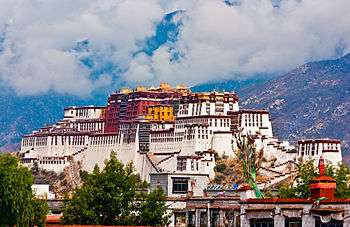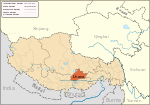Chagpori
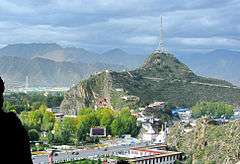

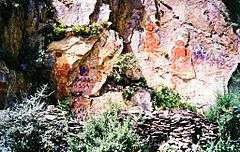
Chagpori, Chakpori, Chokpori, Chagpo Ri (Wylie: lcags po ri , literally "Iron Mountain"; simplified Chinese: 药王山; traditional Chinese: 藥王山; pinyin: Yàowáng shān) is a sacred hill in the city of Lhasa in Tibet, China. It south of the Potala and just to the left when one is facing the Potala. It is considered to be one of the four holy mountains of central Tibet.
Chagpori was the site of the monastic medical college of the same name founded there by Sangye Gyatso in 1696. This medical college, which incorporated a recently restored temple made by Thang Tong Gyalpo, was supplied with revenue generating lands and with a constant stream of students by a "monk tax". It remained an important medical institution in Tibet and Central Asia up until the mid-Twentieth century.[1]
During the March 1959 Lhasa uprising, the medical school and a temple housing statutes of coral (Tsepame), mother-of-pearl (of Tujechempo) and turquoise (of Drolma) were demolished by PLA artillery as the Tibetans had placed a few cannons up there.[2][3][4] It is now crowned by radio antennas,[5][6] which has been viewed as "yet another Chinese attempt to demean the things of value to the people of Tibet."[7] A road has been constructed through the spur that used to connect Chagpori with the Marpori ('Red Hill') on which the Potala is built.
Some rebuilding has since taken place a number of old rock carvings have survived through damage. Some of them are thought to have been carved during the reign of king Songtsän Gampo (605 or 617? - 649 CE) and painted by Nepalese artists.[5] Some buildings have been rebuilt near the base of the hill and there is now again a small temple with prayer wheels.[8]
Tradition has it that the three main hills of Lhasa represent the "Three Protectors of Tibet." Chagpori is the soul-mountain (bla-ri) of Vajrapani, Pongwari that of Manjushri, and Marpori, the hill on which the Potala stands, represents Chenresig or Avalokiteshvara.[9]
Footnotes
- ↑ Meyer, Fernand. (2003). "The Golden Century of Tibetan Medicine" in Lhasa in the Seventeenth Century: Capital of the Dalai Lamas, p. 111. Brill, Boston. ISBN 90-04-12866-2.
- ↑ Dowman, Keith. (1988). The Power-Places of Central Tibet: The Pilgrim's Guide, p. 49. Routledge & Kegan Paul Ltd., London. ISBN 0-7102-1370-0.
- ↑ Lobsang Gyatso, Memoirs of a Tibetan Lama, Snow Lion Publications, 1998, ISBN 1-55939-097-2, p. 262 : "The Tibetan government had one of two cannons on the top of the Chakpori hill near the Potala".
- ↑ Travelin Tibet Archived August 28, 2011, at the Wayback Machine., Going in circles: "The Tibetans placed their few cannon up there and the Chinese destroyed the place."
- 1 2 Mayhew, Bradley and Kohn, Michael. Tibet. 6th Edition (2005), p. 103. Lonely Planet. ISBN 1-74059-523-8.
- ↑ French, Patrick. Tibet, Tibet: A Personal History of a Lost Land. (2003), p. 143. Alfred A Knopf. New York. ISBN 1-4000-4100-7.
- ↑ Travelin Tibet, op. cit.
- ↑ Buckley, Michael and Strauss, Robert. (1986). Tibet: a travel survival kit, p. 133. Lonely Planet Publications, South Yarra, Vic., Australia. ISBN 0-908086-88-1.
- ↑ Stein, R. A. (1972). Tibetan Civilization, p. 228. Translated by J. E. Stapleton Driver. Stanford University Press, Stanford, California. ISBN 0-8047-0806-1 (cloth); ISBN 0-8047-0901-7 (paper).
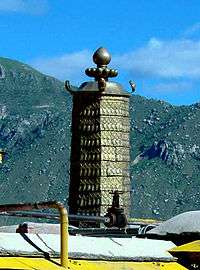
Coordinates: 29°39′08″N 91°06′34″E / 29.6522043°N 91.1094743°E
